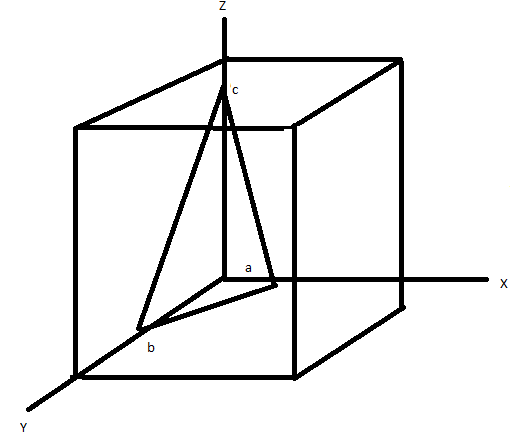
In an orthorhombic crystal, a lattice plane cuts intercepts in the ratio 1:2:3 along a,b and c axes. Find the miller indices of the plane. Sketch the plane and calculate the interplanar spacing, given that a=1A, b=2A and c=3A.
Answer
550.8k+ views
Hint: We have to calculate Miller indices by taking the reciprocals of intercepts and for calculating the interplanar spacing, we have to use the formula,
$\dfrac{1}{{{d_{hkl}}^2}} = \dfrac{4}{3}\left( {\dfrac{{{h^ + } + hk + {k^2}}}{{{a^2}}}} \right) + \left( {\dfrac{{{l^2}}}{{{c^2}}}} \right)$
Here, h, k, and l are miller indices.
Complete step by step answer:
We know that the orthorhombic crystal system is one of the 7 crystal systems.
Orthorhombic lattices comes from enlarging a cubic lattice along two of its orthogonal pairs by two factors, that leads in a rectangular prism with a rectangular base (a by b) and height (c), such that a, b, and c are different.
The intersection of all three bases at 90° angles, so the three lattice vectors remain mutually orthogonal.
We know that Miller indices of a plane are the reciprocals of the intercepts of that corresponding to unit length.
Thus, intercepts are a:b:c=1:2:3.
So let us now take the reciprocals:
$\dfrac{1}{a}:\dfrac{1}{b}:\dfrac{1}{c} = \dfrac{1}{1}:\dfrac{1}{2}:\dfrac{1}{3}$
(or) We can take L.C.M and by taking L.C.M, we get the value of miller indices as 6,3,2.
The value of h is 6.
The value of k is 3.
The value of l is 2.
We can represent the miller indices as $\left( {hkl} \right) = \left( {632} \right)$
Let us now calculate the interplanar spacing for orthorhombic crystals.
$\dfrac{1}{{{d_{hkl}}^2}} = \dfrac{4}{3}\left( {\dfrac{{{h^ + } + hk + {k^2}}}{{{a^2}}}} \right) + \left( {\dfrac{{{l^2}}}{{{c^2}}}} \right)$
Let us now substitute the values of a, c, h, k, and l to calculate the interplanar spacing.
$\dfrac{1}{{{d_{hkl}}^2}} = \dfrac{4}{3}\left( {\dfrac{{{{\left( 6 \right)}^2} + \left( 6 \right)\left( 2 \right) + {{\left( 2 \right)}^2}}}{{{{\left( 1 \right)}^2}}}} \right) + \left( {\dfrac{{{{\left( 2 \right)}^2}}}{{{{\left( 3 \right)}^2}}}} \right)$
$ \Rightarrow $$\dfrac{1}{{{d_{hkl}}^2}} = \dfrac{{760}}{9}$
$ \Rightarrow $${d_{hkl}}^2 = \dfrac{9}{{760}}$
$ \Rightarrow $${d_{hkl}} = \dfrac{3}{{\sqrt {760} }}$
The inter-planar spacing is $\dfrac{3}{{\sqrt {760} }}$.
The plane is sketched as,

Note:
We have to know that in two dimensions there are two orthorhombic Bravais lattices: primitive rectangular and centered rectangular. In three dimensions, primitive orthorhombic, base-centered orthorhombic, body-centered orthorhombic, and face-centered orthorhombic are the four orthorhombic Bravais lattices.
$\dfrac{1}{{{d_{hkl}}^2}} = \dfrac{4}{3}\left( {\dfrac{{{h^ + } + hk + {k^2}}}{{{a^2}}}} \right) + \left( {\dfrac{{{l^2}}}{{{c^2}}}} \right)$
Here, h, k, and l are miller indices.
Complete step by step answer:
We know that the orthorhombic crystal system is one of the 7 crystal systems.
Orthorhombic lattices comes from enlarging a cubic lattice along two of its orthogonal pairs by two factors, that leads in a rectangular prism with a rectangular base (a by b) and height (c), such that a, b, and c are different.
The intersection of all three bases at 90° angles, so the three lattice vectors remain mutually orthogonal.
We know that Miller indices of a plane are the reciprocals of the intercepts of that corresponding to unit length.
Thus, intercepts are a:b:c=1:2:3.
So let us now take the reciprocals:
$\dfrac{1}{a}:\dfrac{1}{b}:\dfrac{1}{c} = \dfrac{1}{1}:\dfrac{1}{2}:\dfrac{1}{3}$
(or) We can take L.C.M and by taking L.C.M, we get the value of miller indices as 6,3,2.
The value of h is 6.
The value of k is 3.
The value of l is 2.
We can represent the miller indices as $\left( {hkl} \right) = \left( {632} \right)$
Let us now calculate the interplanar spacing for orthorhombic crystals.
$\dfrac{1}{{{d_{hkl}}^2}} = \dfrac{4}{3}\left( {\dfrac{{{h^ + } + hk + {k^2}}}{{{a^2}}}} \right) + \left( {\dfrac{{{l^2}}}{{{c^2}}}} \right)$
Let us now substitute the values of a, c, h, k, and l to calculate the interplanar spacing.
$\dfrac{1}{{{d_{hkl}}^2}} = \dfrac{4}{3}\left( {\dfrac{{{{\left( 6 \right)}^2} + \left( 6 \right)\left( 2 \right) + {{\left( 2 \right)}^2}}}{{{{\left( 1 \right)}^2}}}} \right) + \left( {\dfrac{{{{\left( 2 \right)}^2}}}{{{{\left( 3 \right)}^2}}}} \right)$
$ \Rightarrow $$\dfrac{1}{{{d_{hkl}}^2}} = \dfrac{{760}}{9}$
$ \Rightarrow $${d_{hkl}}^2 = \dfrac{9}{{760}}$
$ \Rightarrow $${d_{hkl}} = \dfrac{3}{{\sqrt {760} }}$
The inter-planar spacing is $\dfrac{3}{{\sqrt {760} }}$.
The plane is sketched as,

Note:
We have to know that in two dimensions there are two orthorhombic Bravais lattices: primitive rectangular and centered rectangular. In three dimensions, primitive orthorhombic, base-centered orthorhombic, body-centered orthorhombic, and face-centered orthorhombic are the four orthorhombic Bravais lattices.
Recently Updated Pages
Master Class 11 Chemistry: Engaging Questions & Answers for Success

How many 5 digit telephone numbers can be constructed class 11 maths CBSE

Draw a well labelled diagram of reflex arc and explain class 11 biology CBSE

What is the difference between noise and music Can class 11 physics CBSE

A current I is flowing through wire PQR This wire is class 11 physics CBSE

Find the plane of symmetry center of symmetry and axis class 11 chemistry CBSE

Trending doubts
What is the difference between lightdependent and lightindependent class 11 biology CBSE

1 Quintal is equal to a 110 kg b 10 kg c 100kg d 1000 class 11 physics CBSE

Draw a diagram of nephron and explain its structur class 11 biology CBSE

Swaraj means AComplete Independence B Self rule C Self class 11 social science CBSE

Write the differences between monocot plants and dicot class 11 biology CBSE

Difference Between Prokaryotic Cells and Eukaryotic Cells




